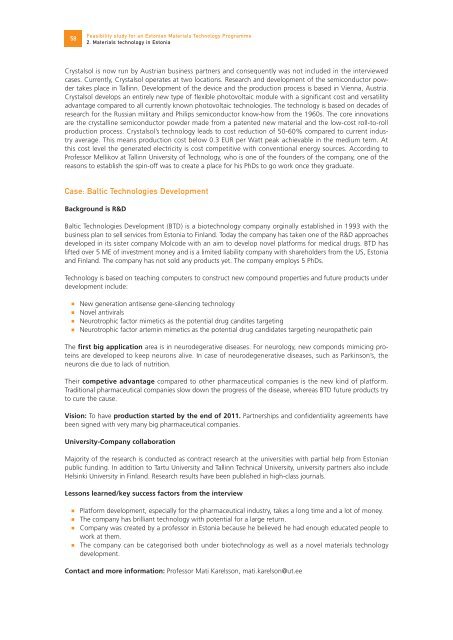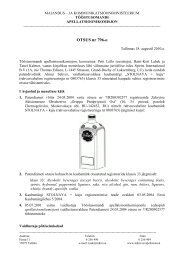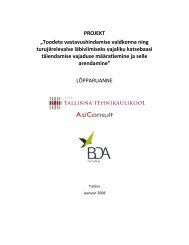Feasibility study for an Estonian Materials Technology Programme
Feasibility study for an Estonian Materials Technology Programme
Feasibility study for an Estonian Materials Technology Programme
Create successful ePaper yourself
Turn your PDF publications into a flip-book with our unique Google optimized e-Paper software.
58<br />
<strong>Feasibility</strong> <strong>study</strong> <strong>for</strong> <strong>an</strong> Estoni<strong>an</strong> <strong>Materials</strong> <strong>Technology</strong> <strong>Programme</strong><br />
2. <strong>Materials</strong> technology in Estonia<br />
Crystalsol is now run by Austri<strong>an</strong> business partners <strong>an</strong>d consequently was not included in the interviewed<br />
cases. Currently, Crystalsol operates at two locations. Research <strong>an</strong>d development of the semiconductor powder<br />
takes place in Tallinn. Development of the device <strong>an</strong>d the production process is based in Vienna, Austria.<br />
Crystalsol develops <strong>an</strong> entirely new type of flexible photovoltaic module with a signific<strong>an</strong>t cost <strong>an</strong>d versatility<br />
adv<strong>an</strong>tage compared to all currently known photovoltaic technologies. The technology is based on decades of<br />
research <strong>for</strong> the Russi<strong>an</strong> military <strong>an</strong>d Philips semiconductor know-how from the 1960s. The core innovations<br />
are the crystalline semiconductor powder made from a patented new material <strong>an</strong>d the low-cost roll-to-roll<br />
production process. Crystalsol’s technology leads to cost reduction of 50-60% compared to current industry<br />
average. This me<strong>an</strong>s production cost below 0.3 EUR per Watt peak achievable in the medium term. At<br />
this cost level the generated electricity is cost competitive with conventional energy sources. According to<br />
Professor Mellikov at Tallinn University of <strong>Technology</strong>, who is one of the founders of the comp<strong>an</strong>y, one of the<br />
reasons to establish the spin-off was to create a place <strong>for</strong> his PhDs to go work once they graduate.<br />
Case: Baltic Technologies Development<br />
Background is R&D<br />
Baltic Technologies Development (BTD) is a biotechnology comp<strong>an</strong>y orginally established in 1993 with the<br />
business pl<strong>an</strong> to sell services from Estonia to Finl<strong>an</strong>d. Today the comp<strong>an</strong>y has taken one of the R&D approaches<br />
developed in its sister comp<strong>an</strong>y Molcode with <strong>an</strong> aim to develop novel plat<strong>for</strong>ms <strong>for</strong> medical drugs. BTD has<br />
lifted over 5 ME of investment money <strong>an</strong>d is a limited liability comp<strong>an</strong>y with shareholders from the US, Estonia<br />
<strong>an</strong>d Finl<strong>an</strong>d. The comp<strong>an</strong>y has not sold <strong>an</strong>y products yet. The comp<strong>an</strong>y employs 5 PhDs.<br />
<strong>Technology</strong> is based on teaching computers to construct new compound properties <strong>an</strong>d future products under<br />
development include:<br />
New generation <strong>an</strong>tisense gene-silencing technology<br />
Novel <strong>an</strong>tivirals<br />
Neurotrophic factor mimetics as the potential drug c<strong>an</strong>dites targeting<br />
Neurotrophic factor artemin mimetics as the potential drug c<strong>an</strong>didates targeting neuropathetic pain<br />
The first big application area is in neurodegerative diseases. For neurology, new componds mimicing proteins<br />
are developed to keep neurons alive. In case of neurodegenerative diseases, such as Parkinson’s, the<br />
neurons die due to lack of nutrition.<br />
Their competive adv<strong>an</strong>tage compared to other pharmaceutical comp<strong>an</strong>ies is the new kind of plat<strong>for</strong>m.<br />
Traditional pharmaceutical comp<strong>an</strong>ies slow down the progress of the disease, whereas BTD future products try<br />
to cure the cause.<br />
Vision: To have production started by the end of 2011. Partnerships <strong>an</strong>d confidentiality agreements have<br />
been signed with very m<strong>an</strong>y big pharmaceutical comp<strong>an</strong>ies.<br />
University-Comp<strong>an</strong>y collaboration<br />
Majority of the research is conducted as contract research at the universities with partial help from Estoni<strong>an</strong><br />
public funding. In addition to Tartu University <strong>an</strong>d Tallinn Technical University, university partners also include<br />
Helsinki University in Finl<strong>an</strong>d. Research results have been published in high-class journals.<br />
Lessons learned/key success factors from the interview<br />
Plat<strong>for</strong>m development, especially <strong>for</strong> the pharmaceutical industry, takes a long time <strong>an</strong>d a lot of money.<br />
The comp<strong>an</strong>y has brilli<strong>an</strong>t technology with potential <strong>for</strong> a large return.<br />
Comp<strong>an</strong>y was created by a professor in Estonia because he believed he had enough educated people to<br />
work at them.<br />
The comp<strong>an</strong>y c<strong>an</strong> be categorised both under biotechnology as well as a novel materials technology<br />
development.<br />
Contact <strong>an</strong>d more in<strong>for</strong>mation: Professor Mati Karelsson, mati.karelson@ut.ee





